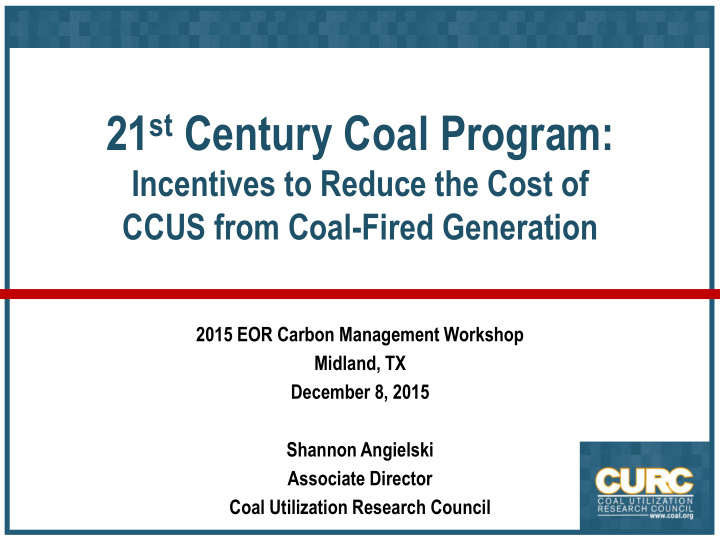



21 st Century Coal Program: Incentives to Reduce the Cost of CCUS from Coal-Fired Generation 2015 EOR Carbon Management Workshop Midland, TX December 8, 2015 Shannon Angielski Associate Director Coal Utilization Research Council
CURC – Who Are We? The Greater Pittsburgh Chamber of ADA-Environmental Solutions State of Ohio, Air Quality Air Products and Chemicals Commerce Development Authority Alstom Power, Inc.*** Illinois Coal Association Tri-State Generation & Transmission American Coal Council Illinois Department of Commerce Association** American Coalition for Clean Coal and Economic Opportunity United Mine Workers of America Electricity (ACCCE) Kentucky Energy and Environment University of Kentucky American Electric Power* Cabinet University of North Dakota’s Energy Arch Coal, Inc.* Lehigh University Battelle & Environmental Research LG&E Energy Basin Electric Power Cooperative Center University of Wyoming Lignite Coal Council The Babcock & Wilcox West Virginia Coal Association Company*** LP Amina West Virginia University Caterpillar Global Mining The Linde Group Wyoming Infrastructure Authority Cloud Peak Energy Mitsubishi Heavy Industries America Wyoming Mining Association CONSOL Energy, Inc. National Rural Electric Cooperative Duke Energy Association (NRECA) Edison Electric Institute (EEI) Ohio State University Electric Power Research Institute Peabody Energy (EPRI) Companies in red indicate 2015 Steering Pennsylvania Coal Alliance Energy Industries of Ohio Committee Members Penn State University FutureGen Industrial Alliance Gas Technologies Institute Southern Company * CURC 2015 Co-chairs (formerly Aerojet Rocketdyne) ** CURC 2015 Vice-Chair *** CURC 2015 Leadership Council 2
21 st Century Coal Program 21 st Century Coal Program Preserve low cost Develop cost effective CCS Build New Plants Today to Ensure electricity from existing technologies to address Future Energy Supply Options fleet global coal use Improve Build new coal Build highly efficient efficiency and Implement the plants with CCS new coal plants operation of Roadmap including a (AUSC) without CCS new program for large existing plants but are “capture scale pilots for Retrofit existing ready” technology readiness by 2025-2035 coal plants with CCS 3
Implement RD&D to Develop Cost Effective CCS and Address Global Coal Use The Roadmap is a plan – to be undertaken in partnership with the federal government – to improve the environmental performance of coal use and • • to continue to deliver low-cost electricity, energy and other valuable coal- derived products to America The Roadmap defines a set of specific technology solutions in order to meet those goals with a recommended federal-industry cost share budget to develop those technologies The costs to implement the Roadmap: Funding ($M/year) 2016-20 2021-25 2026-35 R&D Total (Industry and Federal) 346 241 97 Federal (80%) 277 192 77 Pilots Total (Industry and Federal) 279 322 89 Federal 279 322 89 Demos Total (Industry and Federal) 28 854 654 Federal (50%) 14 427 327 Total (Public/Private) Annual Funding 653 1,416 850 Annual Federal Budget 570 941 493 5
Build Coal and CCS Plants Today to Ensure Future Energy Supply Options What is Needed to Build How Can We Support Coal Coal and CCS Plants Today? and CCS Deployment? Consolidated permitting process and Accelerated Permitting timing limitations to judicial challenges New Coal Plants without Standards that encourage construction CCS (USC) of highly efficient coal plants (USC) New Coal Plants with Adequate and targeted Federal financial CCS incentives to address CCS risks and Policy parity with other low carbon CO 2 Retrofits to Existing emission technologies Plants 6
Risk Considerations that CCS Incentives Must Address Financial Risks • Significant costs and escalation experienced on recent projects Banks and private equity markets are unwilling to finance projects without guarantees that • the technology works Technical Risks • Need to demonstrate performance of CO2 technologies before manufacturers to guarantee performance • Capture and sequestration availability, reliability, flexibility and end-use constraints Operations and Maintenance unknowns Power plants are required to operate 24x7 to meet demand for electricity. Sequestration needs to be demonstrated in integrated operation. Regulatory/Legal Risks Property rights, pore space access, and long-term liability/stewardship • Permitting risk and delay due to permitting challenges • 7
Incentives for Minimizing Risk Today Fall Short DOE funding levels are insufficient and DOE cost share is not enough Investment and production tax credits at traditional levels will not cover the shortfall in capital and operating costs • Commissions fall back on comparative technology options like natural gas combined-cycle (NGCC) to minimize cost and risk. • A meaningful incentive would index the cost of a coal plant w/CCS against NGCC Additional incentives to cover technical risk should problems arise • O&M costs are unknown for any substantial duration 8
CURC Recommendations for Adequate and Targeted Incentives To Address Financial/Operating Risks: • Refundable investment tax credits (grant in lieu of tax credit) • Refundable CO2 sequestration credit or variable price support program • Loan guarantees or access to low cost financing • Price stabilization (contract for differences) on CO2 or electricity prices Regulatory Incentives – Accelerated Permitting Policy parity with other forms of low carbon generating technologies recognizing that CCS is an immature technology when compared to other low carbon generating options 9
What is Required to be Successful? Recognition that there is no one accepted “one size fits all” approach to minimizing the risks • Range of entities with different types of risk or business approaches Cooperatives/G&Ts Developers will little or no tax equity IOUs Merchants Support for adequate incentives targeted to appropriate risk Policy and regulatory parity with low carbon alternatives Active support and advocacy from all actors in the supply chain Nationally recognized business leaders expressly advocating for technology including CCS 10
Questions? Thank you! Shannon Angielski, Associate Director, CURC www.coal.org Contact Information: (202)298-1825 sma@vnf.com
Recommend
More recommend